Blockade of astrocytic glutamate uptake in rats induces signs of anhedonia and impaired spatial memory
- PMID: 20531459
- PMCID: PMC3055299
- DOI: 10.1038/npp.2010.74
Blockade of astrocytic glutamate uptake in rats induces signs of anhedonia and impaired spatial memory
Abstract
Mood disorders are associated with regional brain abnormalities, including reductions in glial cell and neuron number, glutamatergic irregularities, and differential patterns of brain activation. Because astrocytes are modulators of neuronal activity and are important in trafficking the excitatory neurotransmitter glutamate, it is possible that these pathologies are interrelated and contribute to some of the behavioral signs that characterize depression and related disorders. We tested this hypothesis by determining whether depressive-like signs were induced by blocking central astrocytic glutamate uptake with the astrocytic glutamate transporter (GLT-1) inhibitor, dihydrokainic acid (DHK), in behavioral tests that quantify aspects of mood, including reward and euthymia/dysthymia: intracranial self-stimulation (ICSS) and place conditioning. We found that DHK elevated ICSS thresholds, a depressive-like effect that could reflect reduced sensitivity to reward (anhedonia) or increased aversion (dysphoria). However, DHK treatment did not establish conditioned place aversions, suggesting that this treatment does not induce dysphoria. To identify the brain regions mediating the behavioral effects of DHK, we examined c-Fos expression in areas implicated in motivation and emotion. DHK increased c-Fos expression in many of these regions. The dentate gyrus of the hippocampus was robustly activated, which led us to explore whether DHK alters hippocampal learning. DHK impaired spatial memory in the MWM. These findings identify disruption of astrocyte glutamate uptake as one component of the complex circuits that mediate anhedonia and cognitive impairment, both of which are common symptoms of depression. These finding may have implications for the etiology of depression and other disorders that share the features of anhedonia and cognitive impairment.
Figures
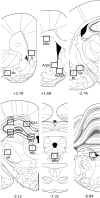


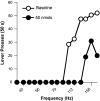


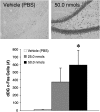
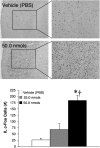
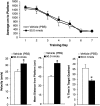
Similar articles
-
Blockade of astrocytic glutamate uptake in the prefrontal cortex induces anhedonia.Neuropsychopharmacology. 2012 Oct;37(11):2467-75. doi: 10.1038/npp.2012.105. Epub 2012 Jun 27. Neuropsychopharmacology. 2012. PMID: 22739467 Free PMC article.
-
Blockade of the GLT-1 Transporter in the Central Nucleus of the Amygdala Induces both Anxiety and Depressive-Like Symptoms.Neuropsychopharmacology. 2015 Jun;40(7):1700-8. doi: 10.1038/npp.2015.16. Epub 2015 Jan 14. Neuropsychopharmacology. 2015. PMID: 25586634 Free PMC article.
-
Glia mechanisms in mood regulation: a novel model of mood disorders.Psychopharmacology (Berl). 2007 Mar;191(1):55-65. doi: 10.1007/s00213-006-0652-4. Epub 2007 Jan 16. Psychopharmacology (Berl). 2007. PMID: 17225169
-
Towards a glutamate hypothesis of depression: an emerging frontier of neuropsychopharmacology for mood disorders.Neuropharmacology. 2012 Jan;62(1):63-77. doi: 10.1016/j.neuropharm.2011.07.036. Epub 2011 Aug 3. Neuropharmacology. 2012. PMID: 21827775 Free PMC article. Review.
-
Stress-induced deficits in cognition and emotionality: a role of glutamate.Curr Top Behav Neurosci. 2012;12:189-207. doi: 10.1007/7854_2011_193. Curr Top Behav Neurosci. 2012. PMID: 22261703 Free PMC article. Review.
Cited by
-
Ketamine decreases resting state functional network connectivity in healthy subjects: implications for antidepressant drug action.PLoS One. 2012;7(9):e44799. doi: 10.1371/journal.pone.0044799. Epub 2012 Sep 24. PLoS One. 2012. PMID: 23049758 Free PMC article. Clinical Trial.
-
Long-term NMDAR antagonism correlates reduced astrocytic glutamate uptake with anxiety-like phenotype.Front Cell Neurosci. 2015 Jun 3;9:219. doi: 10.3389/fncel.2015.00219. eCollection 2015. Front Cell Neurosci. 2015. PMID: 26089779 Free PMC article.
-
SLC1A3 C3590T but not BDNF G196A is a predisposition factor for stress as well as depression, in an adolescent eastern Indian population.BMC Med Genet. 2020 Mar 14;21(1):53. doi: 10.1186/s12881-020-0993-6. BMC Med Genet. 2020. PMID: 32171272 Free PMC article.
-
Glutamine Supplementation Ameliorates Chronic Stress-induced Reductions in Glutamate and Glutamine Transporters in the Mouse Prefrontal Cortex.Exp Neurobiol. 2019 Apr;28(2):270-278. doi: 10.5607/en.2019.28.2.270. Epub 2019 Apr 30. Exp Neurobiol. 2019. PMID: 31138994 Free PMC article.
-
Relationship between genetic variation in the glutaminase gene GLS1 and brain glutamine/glutamate ratio measured in vivo.Biol Psychiatry. 2011 Jul 15;70(2):169-74. doi: 10.1016/j.biopsych.2011.01.033. Epub 2011 Mar 31. Biol Psychiatry. 2011. PMID: 21457947 Free PMC article.
References
-
- Anderson CM, Swanson RA. Astrocyte glutamate transport: review of properties, regulation, and physiological functions. Glia. 2000;32:1–14. - PubMed
-
- Andreasen NC, Olsen S. Negative v positive schizophrenia. Definition and validation. Arch Gen Psychiatry. 1982;39:789–794. - PubMed
-
- Arango V, Underwood MD, Mann JJ. Fewer pigmented locus coeruleus neurons in suicide victims: preliminary results. Biol Psychiatry. 1996;39:112–120. - PubMed
Publication types
MeSH terms
Substances
Grants and funding
LinkOut - more resources
Full Text Sources
Other Literature Sources
Medical

